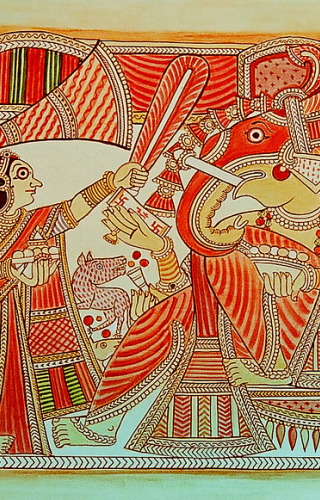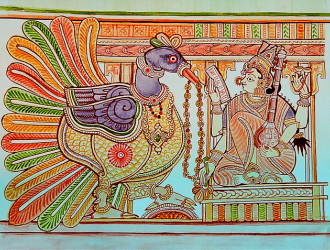The fieldwork for the National Folkore Support Centre's exhibition in Chennai in 2002 was the initiation into the picture story-telling tradition of Maharashtra: the Chithrakathi. 'Chithra' is painting and 'Katha' is story. The tradition of telling these mythical and historical stories was alive on the Maharashtra/Karnataka border and in parts of Andhra Pradesh. Broadly speaking, Chitrakathi is identified in three forms, viz., leather shadow puppets, wooden string puppets and picture stories. The former two are identified distinctly by their own names while the latter is only now identified as 'Chitrakathi'. The story teller holds a 'Tuntuna' or a 'Tampura' (pitch) and is accompanied by cymbals (Rhythm) and 'Huduk' (percussion).
Very few performers of this tradition are available today in Maharashtra. Shri Parashuram Vishram Gangawane in a village called Pinguli near Kudal in the Sindhudurg district of Maharashtra is notable for his chithrakathi performance. The pictures are in bundles called pothi and every story is bundled in a pothi comprising 50 to 60 pictures. The pictures used as visual support resemble the string puppets of the region.
A few sets of paintings came into the custody of the Raja Dinkar Kelkar Museum in Pune from Paithan. These paintings of chithrakathi vary greatly from what is available in Pinguli. These resemble the images of leather puppets of northern Karanataka and Maharashtra.
The remarkable structure of these paintings tempted the study of these and around 20 persons were taught in two workshops in 2008 and 2012. The lessons continued in making replicas. Further, with seven participants from the workshop, plans were made to work on something more.
The Bharatha-k-koothu, a vibrant and popular theatre in the northern parts of Tamil Nadu is a tradition attracting many viewers. During the months of Chithirai and Vaikasi, the Draupadi Amman temple celebrates its elaborate festival for around 20 days. The festival starts with flag hoisting and goes on with pomp and gaiety all over the village. The 'Mahabharatha Prasangam' takes up a part of the day, with many rituals in the temple, of which some relate to the practices of war communities in the past. The 'Bharatha Prasangam' not only elaborates the main Mahabharatha but also has many stories and snippets from local versions attached to the land and people of the region. On the seventh or eighth day the ceremonial 'avatharam' of the goddess Draupadi is performed as a ritual in the temple and the Bharatha-k-koothu is performed all night on a stage, usually facing the temple, and as a community theatre bringing the epic alive all around the village, and involving all the villagers.
The people of the place live along with Mahabharatha throughout the entire festival becoming a part of the great epic listening to the story during the day and seeing the characters come alive during the night and interacting with them. The Mahabharatha is divided into many episodes and enacted as Arakku Maligai, Bagasura Vadham, Vil Valaippu, Subhadra Kalyanam, Rajasuyam, Pagadai Thugil, Arjunan Tabasu, Draupadi Kuravanji, Keechaka Vadham, Maadu Pidi Sandai, Krishnan Thoodhu, Aravan Kala Bali, Abimannan Kadhai, Karna Moksham, Padhinettam Por. The entire festival comes to an end with the Duryodhanan Padukalam where a huge mud effigy of the great Kaurava is made and the final episode of Mahabharatha is enacted where Bhima slays Duryodhana and Krishna helps Draupadi tie her hair after she applies the blood of the Kaurava hero. On the evening of that day the fire walk—'Theemidhi' or 'Akkinivasantha Vizha' as it is called—takes place followed by the 'Karumadhi' for the deceased and the Dharmaraja Pattabhishekam on successive days.
It is not new for an artist to get inspired by this vibrant and spectacular tradition. Strokes of the great masters of our place such as Thiru Adimoolam's stand testimony for the spell cast by the folk theatre. Having decided to venture into painting the same in the chithrakathi style the artist participants started exploring the details. They were told to read the books of Alfred Hiltebitel on the Cult of Draupadi, Thiru Mu Ramasamy's books on Theru-k-koothu, Thiru S. Ramakrishnan's Upapandavam, Thiru Na Muthusamy's Padukalam, Dr. Hanne M. De Bruin's 'Karna Mokaham' etc. Thiru M.D. Muthukumaraswamy, Director, National Folklore Support Centre was kind enough to expose the artists to documentation done by the Centre on this subject. Thiru Sashikanth's documentaries Kelai Draupadai and Ninaivin Nagaram helped the artists to know more about the subject. The 1989 film version of the Mahabharata directed by Peter Brook gave an insight to the artists on how to portray the epic highlighting the symbolism and metaphors to add value to the context.
Having done their homework the artists were requested to go on field trips to the centers of activity around the northern parts of Tamil Nadu to experience the vibes of the tradition. The subject was vast and they were requested to choose any part of it which inspired them to make the story for their painting. After visiting various places such as Nemili, Kannal, Thiruporur, Salavakkam, Paranur, Koovagam, Pondicherry, etc, each artist settled with their stories. Indira Seshadri chose the story of Karna, Meenakshi Madan was inspired by the 'Padukalam', Rajashri Manikandan by the 'Pagadai Thugil' episode, Shanmugha Priya was fascinated by the 'Panchala Kuravanji', Shobha Rajagopalan's admiration was for the 'Arjunan Tabasu', Suresh decided to paint the story of Aravan, and Vaishnavi Srikanth opted for the 'Abimannan Kadhai'.
The Chithrakathi paintings of Paithan resemble the structures of the leather shadow puppets and were done using natural pigments. However we opted to go in for the watercolour or gouache paints available on the market. The Chithrakathi paintings were done on handmade or mill-made paper of approximately 22 cm x 42 cm to cater to the need of storytelling before a small audience of 20 to 30 people. But the real demand for the style being extinct we chose to stretch our canvas a little further to 53 cm x 73 cm. All the artists worked on their stories displaying them in six to eight paintings each. Being an experimental project, fragments of the stories were done.
The 'Chithrakathi' is a picture storytelling tradition and as a complement to the visual, narration and singing carries on to elaborate the story to give a complete form. Even after the pictures were painted the tradition of narration had to be completed, for which we approached Thiru Shankararamasubramanian, poet, and requested him to embellish our visuals with his words. Under great pressure of time, the fabulous work of Shankararamasubramanian created a new dimension to the works of the artists giving it the complete 'Chithrakathi' flavour.
The 'Innerflow' of the underlying currents of the Maharashtrian storytelling tradition and the Bharatha-k-koothu performances have blended into a traditional-contemporary visual with the poems of Shankararamasubramanian.
The works were exhibited at the Lalit Kala Akademi, Chennai in September 10–12, 2012, accompanied by two symposia on 'Transposed Traditions' where eminent scholars, artists, performers participated.
The works were displayed at the Dakshinachithra, Muttukadu, Chennai in January 9–30, 2013, during which period a two-day workshop on Chithrakathi paintings was also held.
The works were exhibited at the Hutheesing Visual Art Centre, Ahmedabad in April 9–14, 2015.
The team Innerflow today is working on various aspects of the Bharatha-k-koothu, exploring the Draupadi cult and its parallels and trying to represent the current status of the performance and practices in depictions of the vibrant epic in the spectacular frames of the Paithani Chithrakathi visual.













